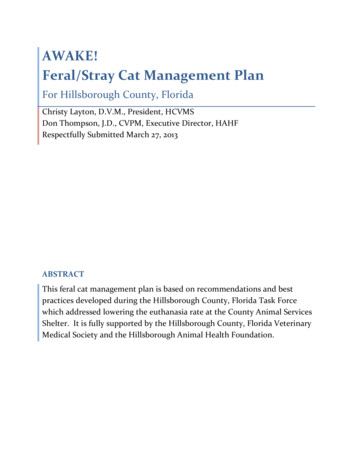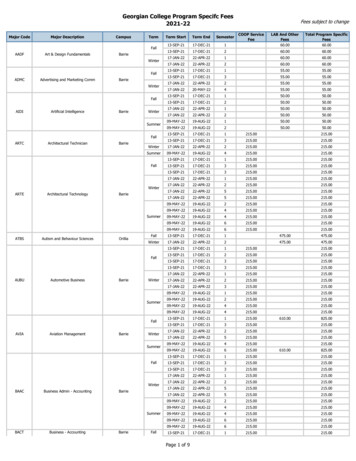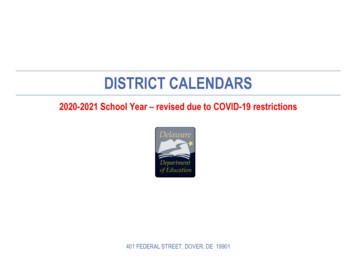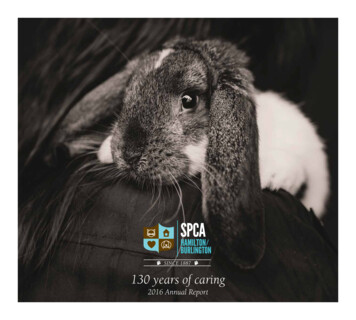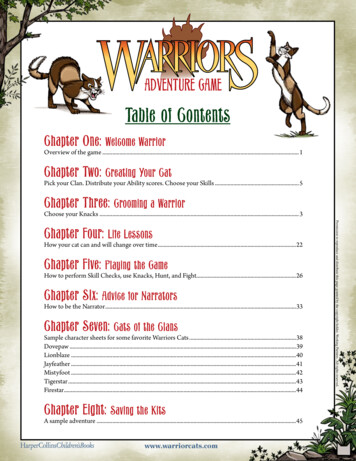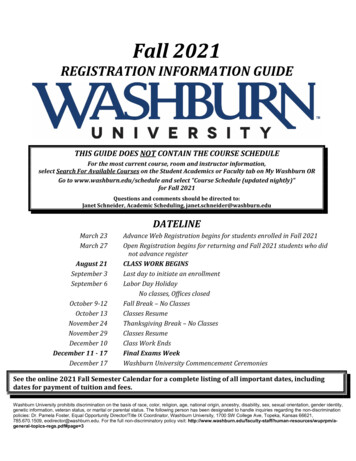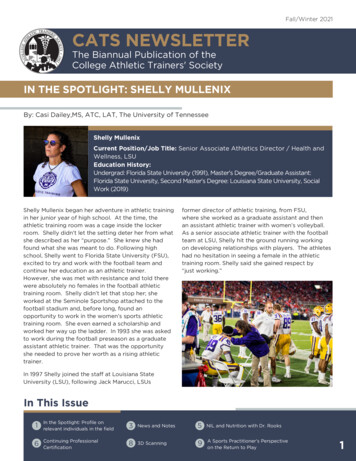
Transcription
Fall/Winter 2021CATS NEWSLETTERThe Biannual Publication of theCollege Athletic Trainers' SocietyIN THE SPOTLIGHT: SHELLY MULLENIXBy: Casi Dailey,MS, ATC, LAT, The University of TennesseeShelly MullenixCurrent Position/Job Title: Senior Associate Athletics Director / Health andWellness, LSUEducation History:Undergrad: Florida State University (1991), Master's Degree/Graduate Assistant:Florida State University, Second Master's Degree: Louisiana State University, SocialWork (2019)Shelly Mullenix began her adventure in athletic trainingin her junior year of high school. At the time, theathletic training room was a cage inside the lockerroom. Shelly didn’t let the setting deter her from whatshe described as her “purpose.” She knew she hadfound what she was meant to do. Following highschool, Shelly went to Florida State University (FSU),excited to try and work with the football team andcontinue her education as an athletic trainer.However, she was met with resistance and told therewere absolutely no females in the football athletictraining room. Shelly didn’t let that stop her; sheworked at the Seminole Sportshop attached to thefootball stadium and, before long, found anopportunity to work in the women’s sports athletictraining room. She even earned a scholarship andworked her way up the ladder. In 1993 she was askedto work during the football preseason as a graduateassistant athletic trainer. That was the opportunityshe needed to prove her worth as a rising athletictrainer.former director of athletic training, from FSU,where she worked as a graduate assistant and thenan assistant athletic trainer with women’s volleyball.As a senior associate athletic trainer with the footballteam at LSU, Shelly hit the ground running workingon developing relationships with players. The athleteshad no hesitation in seeing a female in the athletictraining room. Shelly said she gained respect by“just working.”In 1997 Shelly joined the staff at Louisiana StateUniversity (LSU), following Jack Marucci, LSUsIn This Issue1In the Spotlight: Profile onrelevant individuals in the field3News and Notes5NIL and Nutrition with Dr. Rooks6Continuing ProfessionalCertification83D Scanning9A Sports Practitioner’s Perspectiveon the Return to Play1
In addition to having the support of Jack and theplayers, the head football coach at the time, CoachGerry DiNardo, was married to an athletic trainer. Shesaid that helped the rapport between Coach DiNardoand the athletic training staff, because he was awareof what athletic trainers knew and the role they playedon a team. At the time, Shelly was 28 years old andsays that she was able to relate with the athletes.Over time, they realized she could be trusted and thatshe wouldn’t overreact or underreact. She recalled anincident where two players were physically fighting,and she stepped between them without hesitation.Luckily, she wasn’t harmed and reported that they justneeded a mother figure, and at times that was the roleshe played.When a student-athlete died by suicide during hersecond year at LSU, Shelly decided to pursue moretraining in the mental health field. She felt like thatwas a missed opportunity to help someone. Thatincident motived her, and she decided that from thatpoint on it would not always be about the athleticfeat, but the person. It took a crisis for there to be apositive change and for Shelly to solidify her beliefsand career direction. As her career progressed, shenoticed she was doing some informal counseling withthe players and at the time did not have any advancedtraining in counseling. That led her to pursue her socialwork degree. She took 1-2 classes a year whilecontinuing to work as an athletic trainer with thefootball team, and in 5 years, she obtained her secondmaster’s in social work in 2019.through this consulting work that the sitting AthleticDirector (AD) Scott Woodward hired Shelly as aconsultant to the Athletic Department at theUniversity of Washington. Fast forward several yearsand Scott Woodward was hired as the AD at LSU andasked Shelly to be the AD for Health & Wellness.Shelly knew that LSU needed to establish autonomy inathletic training and mental health. She now overseesAthletic Training, Mental Health, Strength &Conditioning, and the Nutrition departments.When asked “What’s next?” Shelly admitted to being aconstant worrier. She elaborated by saying she thinksthat helps her stay ahead of things. She is ready forthe catastrophe. Specifically looking at the field ofmental health, she feels like we need to expand onwhat we are offering our student-athletes and startoffering resources to our coaches and support staff.She wants to continue to create community in theentire athletic department at LSU. Shelly talked abouteducating the entire department on the importance ofmental health resources. She wants to engage inconversations about race and relationships, striving tochange the culture of athletics.Shelly has been a trailblazer in our field from thebeginning of her career. She has constantly brokendown barriers and fought for what is best for herstudent-athletes. By continuing to educate herself,she has transformed the way we treat athletes; shechallenged us to treat them holistically instead of justfocusing on an acute injury limiting them in their sport.Shelly has come a long way from the cage in thefootball locker room at her Miami high school. We arelucky to have her consistently fighting for change andchallenging us to be better clinicians.When football coach Nick Saban left LSU for theMiami Dolphins, he wanted Shelly to join him. WhileMiami is where Shelly grew up, she knew she did notwant to make the move to the NFL full time.Eventually, she developed an LLC (Integrated SportsManagement) and became a consultant. This allowedher to work with other, non-competing Division onecollegiate programs to help them integrate criticalcomponents of student-athlete wellness. It was2
NEWS AND NOTESFueling Greatness Education GrantAward RecipientsBy: Kristen Mostrom, MPA, LAT, ATC, EMTCriteria To Be Considered and Met:The Fueling Greatness Education Grant sponsored byGatorade recognizes CATS members who have helpedadvance their institution’s sports medicine programsand improved their student-athlete services.Presented each spring, this grant will help support thecontinuing education for three (3) deserving CATSmembers who will be awarded 1,000 to assist withtheir expenses in attending the upcoming CATSSpring Symposium.To find more information about this continuingeducation grant, Congratulations to our 2020 Recipients forFueling for Greatness Education GrantMelanee Johnson, University of DelawareHannah Jaussen, US Naval AcademyNathan Wilder, Towson UniversityMelanee Johnson, Univeristy of DelawareMelanee is currently in her 6th year at the Universityof Delaware. Johnson does not only exceed in herday-to-day duties working with the Women’sBasketball team and administrative duties, but hasgone above and beyond within both the AthleticDepartment and ATEP program at U of D. Melanee hasbeen wearing numerous hats while being employed atDelaware, including but not limited to being a part ofthe Athletics & Recreation Services Diversity &Inclusion Committee, the Student Athlete AdvisoryCommittee, and serves as the Athletic TrainingNutrition Liaison. On top of these numerouscommittees, Melanee has a true passion for workingwith her female student-athletes and has created theWomen’s Health Education resource center. Thisresource center is a comprehensive presentation andprogram that includes team lectures, handouts,referral process for individual meetings, and mostimportantly, preventative education to keep femalestudent-athletes at their personal best. Though thisprogram is new and ever so evolving, this is a strongpassion of Melanee that she hopes will continue toevolve on an annual basis. It appears that withJohnson’s work ethic and dedication, this is bound tobe a very successful service that the femalepopulation at the University of Delaware will greatlybenefit from within the athletic department.Melanee’s supervisor, Dan Watson, Head AthleticTrainer at the University of Delaware, says, “We have astronger Athletic Department due to her initiative. Sheshows her dedication to the Athletic Training fieldthrough her volunteerism within the University ofDelaware athletic department and state organization(DATA) with her work leading both organization’sEthnic Diversity Action Committees.”Hannah Jaussen, US Naval AcademyHannah has been working at the US Naval Academysince June of 2018. Hannah was brought on staff tohelp implement the ongoing NCAA/DoD CAREconsortium concussion research program amongsttheir athletic population. Hannah immediately hit theground running when hired on with this project andbegan rewriting the Naval Academy’s concussionmanagement policy to reflect the most up to dateprotocols. This solo project was not an easy task. Shehad to meet with numerous individuals on base,bridging gaps between certain athletic departmentand coaching staff members, multiple meetings withacademic deans, administrators, and other healthcareprofessionals, etc. on top of her regular daily duties.This was a very new educational opportunity that shewas able to develop to better serve the health andwell-being of their student-athletes. Bridging the gapswithin these individuals allowed for a betterstandardized level of care and a multidisciplinaryapproach among the student-athletes and the entirebrigade of Midshipmen.Dr. Adam Susmarski, the team physician at UnitedStates Naval Academy, commented, “Hannah washand-picked from a large competitive pool ofapplicants to join an emerging team of medicalleadership to improve con-cussion care forMidshipmen at the Naval Academy. Hannah wasinstrumental in a project that revolution-izedconcussion care at the Naval Academy, which hasseen the department grow from one individual to amultidisciplinary team of 12 medical professionals!Through Hannah’s hard work and steadfast leadership,concussion care at the Naval Academy has gone froman understaffed department with a bruised reputation to a well-staffed linchpin in the Naval Academycommunity with an excellent rapport throughout theYard!”3
Nathan Wilder, Towson UniversityAn employee since 2011, Nathan Wilder currentlyserves as the Senior Associate Athletic Director forSports Medicine and Performance at TownsonUniversity. Upon arrival, Nathan was charged withfollowing in the footsteps of a 30-year veteran HeadAthletic Trainer to establish new goals and objectivesto launch a medical performance model that woulduse community resources to ensure delivery of qualitymedical services. Nathan took part in establishingpartnerships and new staff, physicians, policies andprocedures, electronic medical records, growth offacilities, and establishing cost containment strategiesto ensure proper care for their student-athletes. Thiswas a considerable project. Nathan played an integralrole in changes to their athletic department’s strengthand conditioning and nutrition programs. Thesechanges allowed for restructuring and a better senseof collaboration in performance amongst the medicaland athletic staff members. Refocusing ofresponsibilities allowed for better communication,2021 CATS Family ScholarshipRecipientsCATS would like to congratulate the 2021-22 CATSFamily Scholarship recipients.CATS Family Scholarship recipients show successacademically, demonstrate qualities of a leader and areactively involved within their communities. Many evenassist their parents with the financial responsibilities ofa college education. We wish our new recipients greatsuccess and hope they continue to work hard in theirrespective studies, achieve their goals with greatsuccess and make their parents proud.Moose Detty Scholarship sponsoredby PRO OrthopedicsWarner Hardin will be a senior at theUniversity of Texas at Austin andmajoring in Biochemistry. He is theson of Allen Hardin at the Universityof Texas at Austin.Otho Davis Scholarship sponsored byCDM SportSydney Franklin attends BowlingGreen State University and plans tomajor in Architecture. She is thedaughter of Jason Franklin at WrightState University.stronger dedication towards injury prevention,performance enhancement, rehabilitation, andnutrition. Nathan feels these changes have allowed forembracing an educational culture amongst all staffmembers and their student-athletes. Growth continuesto take place at Townson University thanks toNathan’s hard work efforts and dedication to theathletic population.Deputy Director of Athletics and Senior Women’sAdministrator, Tricia Turley, at Townson Universitysays, “I am not exaggerating when I say that Nathanhas revolutionized our sports medicine program andthe service they provide to our student-athletes andhas built a model sports medicine and sportsperformance program here at Townson University. Heis constantly looking for opportunities to improve andis creative in finding ways to innovate and provide agreater service to the department and our studentathletes.”Dan Gorman Scholarship sponsoredby CDM SportRyan Sunderland attends IllinoisState University and plans to major inEducation. He is the son of ScottSunderland at Knox College.Gatorade CATS Family ScholarshipOlivia Herod is a sophomore atClemson University and is majoring inMarketing. She is the daughter ofJennifer and Kevin Herod at theUniversity of South Carolina.Hydroworx CATS Family ScholarshipCade Bennett is a senior at theUniversity of Puget Sound and ismajoring in International Businessand Hispanic International Studies.He is the son of Craig Bennett,University of Puget Sound.Litecure CATS Family ScholarshipZachary Jones attends the Universityof Toledo and plans to major inBusiness with a possible minor inFinance. He is the son of Brian Jonesat the University of Toledo.Is your child college bound? Does he or she qualify for our scholarship? To find out if your child qualifies for theCATS Family Scholarship and to find out how to apply visit s4
NIL AND NUTRITIONBy: Richard Campbell MS, ATC, LAT,Rutgers UniversityStarting on July 1, 2021, collegiate student-athleteswere granted the opportunity to benefit from theirname, image, and likeness (NIL). The NationalCollegiate Athletic Association (NCAA) president andgoverning body understand that this policy is in itsinfancy stage and has passed an interim policy thatallows student-athletes to profit from their NIL until apermanent solution can be found.NCAA president, Mark Emmert states, "With thevariety of state laws adopted across the country, wewill continue to work with Congress to develop asolution that will provide clarity on a national level.The current environment — both legal and legislative— prevents us from providing a more permanentsolution and the level of detail student-athletesdeserve."1This interim policy is to help prevent/avoidpay-for-play across all levels of the NCAA for athletesdeciding on what institution to attend for a fairrecruiting /playing field. "The new policy preservesthe fact college sports are not pay-for-play," saidDivision II Presidents Council chair Sandra Jordan,chancellor at the University of South Carolina Aiken.2"It also reinforces key principles of fairness andintegrity across the NCAA and maintains rulesprohibiting improper recruiting inducements. It'simportant any new rules maintain these principles."Simply put, schools should not be providing orassisting student-athletes with NIL endorsements. Inaddition, student-athletes should refrain fromaccepting compensation in exchange for athleticperformance or participation, or as an inducement forenrollment.So how does NIL relate to our athletic trainers andnutrition staffs that provide for student-athletes?Although the new NIL policy allows student-athletesto be sponsored, they must remember thatsupplements are not regulated by the U.S. Food andDrug Administration. As it was before NIL waspassed, student-athletes are ultimately responsible forwhat they put into their bodies. At Rutgers University,we are fortunate to have a staff of registered dietitianswho can educate our student-athletes on what theyshould and shouldn’t be consuming. When it comes toNIL, our registered dietitians can meet with thestudent-athlete if they have a NIL opportunity andadvise them on the pros and cons of the supplementbefore signing with said company. Ultimately ournutrition staff wants all products consumed by ourstudent-athletes safe, effective, and reputable; do notlet a potential sponsor put health and eligibility at risk.Our nutrition staff would advise student-athletes tomake sure all supplements are third party tested. Allstudent-athletes should also remember to ensure thatthe ingredients have been tested and look for theselabels:Even if a supplement claims they are, they might notactually test the ingredients in the product. Someproduct claims or practices to be wary of include:“NCAA certified” or “NCAA approved” There is no such thing as an “NCAA Approved orCertified” supplement.“Boosts” immunity or prevents disease There is no supplement that has been proven toprevent most diseases, including COVID-19.“Detox”, “fat burner”, “cleanse” These words are red flags for supplements! Theyare not only untrue, but often indicate thepresence of banned substances.Extreme muscle gain/weight loss Any type of rapid weight gain or loss is not goingto be beneficial for your health or performance.Talk with your Sports RD to help achieve yourgoals sustainably.Product is being sold without a list of ingredients Without a list of ingredients, there is no way toevaluate the safety of the product.Being aware of what a supplement consists of is theutmost importance, but student-athletes need to becautious if a company asks the following questions: Are they selling you a food product, like smoothiesor drinks, but aren’t telling you the ingredients? Are they asking you to recruit your friends to helpsell their product? Are they asking for before and after pictures afterusing the product?If you answer ‘YES” to any of these questions,beware of working with them!5
The grey area that we run into not only as an athletictraining/nutrition staff, but also as an entire athleticdepartment, is what happens if a student-athleteworks with a brand that is a competitor or may breacha contract with an athletic departments’ sponsorship?The NCAA cannot provide guidance on issues of statelaw. The state you live in and where a student-athletemay wish to enroll may have NIL laws with which youwill want to be familiar.For example, in the state of New Jersey, studentathletes must follow the New Jersey Fair Play Act.“The bill provides that a student-athlete who entersinto a contract providing compensation to thestudent-athlete for use of his name, image, or likenessmust disclose the contract to an official of the fouryear institution of higher education, to be designatedby the institution. An institutional team contract maynot prevent a student-athlete from using the athlete'sname, image, or likeness for a commercial purposewhen the athlete is not engaged in official teamactivities.”3 Ultimately, a student-athlete may decideto sign a contract with a certain company, but theycannot promote that company while participating inCONTINUING PROFESSIONALCERTIFICATION: OVERVIEWAND EXPLANATION OFPROPOSED CONCEPTBy: Board of Certification (BOC)for the Athletic TrainerBackground and OverviewRecertification is changing in health care. The Board ofCertification (BOC) for the Athletic Trainer, with inputfrom Athletic Trainers (ATs) in all settings, is nowshaping a new recertification concept, ContinuingProfessional Certification or CPC, to offer a morecustomized and efficient professional developmentprogram. The concept is meant to provide ATs theflexibility to map out an individualized professionaldevelopment plan based on their preferred learningstyle, professional goals, and practice setting.The ultimate goal of the final concept is to provideconsumers the comfort of knowing all ATs are stayingcurrent with cutting-edge knowledge and skills in thefield of athletic training - in line withNational Commission of Certifying Agencies (NCCA)accreditation excellence.an institution event or wearing their institution’sclothing. Regardless of what sponsorships studentathletes decide to sign, they should be informing thecompliance office to prevent eligibility or legal issues.Our last advice from our registered dietitians atRutgers University when speaking with studentathletes in regard to working with nutritional brandsare: Does this product align with my goals or sport/position needs for performance? Do I agree with what the brand is promoting? How will this help me be a positive role model formyself and others?References:1. NCAA adopts interim name, image, and likeness policy. Interim policy goes intoeffect Thursday. June 30, 2021 Michelle Brutlag ess-policy2. NCAA Interim Policy Updates. https://www.ncaa.org/about/taking-actionName, Image and Likeness Interim PolicyName, Image and Likeness Interim Policy Q&AQuick Guide to New Interim NCAA PolicyNew Interim Policy Key Takeaways3. NJ S971 "New Jersey Fair Play Act"; allows collegiate student-athletes to earncompensation for use of name, image, or likeness.CPC is overall guidance for health care professionals’requirements for continuing competence andmaintenance of certification that are grounded in thecore competencies identified in the Institute ofMedicine (IOM), now the National Academy ofMedicine (NAM) report “Health Professions Education:A Bridge to Quality” (2003) and reiterated in otherIOM/ NAM reports, such as “Redesigning ContinuingEducation in the Health Professions” (2010), as well asthe latest edition of the Institute of CredentialingExcellence (ICE) “Certification: The ICE Handbook”(2019). Provide patient-centered care Work in interdisciplinary teams Employ evidence-based practice Apply quality improvement Utilize informaticsEvidence has shown that continuing education units(CEUs) alone aren’t as effective or practical as theycould be across the health care professions, and muchof the medical field is evolving their approach,including nursing, occupational therapy, physicianassistants, and dietetics.In 2016, the BOC convened the Maintenance ofCompetence Task Force, which included ATs fromvarious professional settings and members of thestrategic alliance that worked ongoing and provided6
regularly communicated updates. In addition,beginning in 2020, the BOC’s volunteer CPC AdvisoryPanel and Standards Committee collaborated todevelop the current CPC program recommendationsafter testing many components, including ProfessionalGoals Appraisal (PGA), Competence AssessmentModels (CAMs) and Quality Improvement (QI)projects, with successful pilot results.We’ve gathered input from many ATs during our 2020pilot programs. Below you will find summaryoutcomes from two of the pilots.Competency Assessment Modules (CAMs):Mental Health Pilot774 ATs from 14 different practice settingscompleted the CAMs – Mental Health pilot. In a postpilot survey, participants agreed the CAMs improvedtheir knowledge of mental health as well as theirawareness of strengths and weaknesses in this area.Specifically, over 92% of participants “Agreed” or“Strongly Agreed” the CAMs “Improved myknowledge of mental health.”QI: Facility Principles Pilot115 ATs from a variety of practices settings completedthe QI - Facility Principles Pilot. In a post-pilot survey,participants indicated the process improved theirawareness of areas for improvement, strengths and/orcompliance and ultimately enhanced patientoutcomes. Specifically, over 70% of participants“Agreed” or “Strongly Agreed” the project “Enhancedmy patients’ outcomes.”Setting-Specific Examples of QIsCollege Athletic Trainer or Athletic Health CareAdministrator: An assessment of the athletic trainingfacility using the BOC’s free Facility Principles toolmay provide opportunity for quality improvement. Theimprovement could be as simple as hanging yourlicense on the wall to something a little more complexsuch as addressing gaps in documentation. In fact, anAT who participated in the pilot project indicated thatit allowed them to have conversations with theiradministrators and others regarding their facility tomake it a safer environment for students.many healthcare or community associated settings.Proper hand hygiene by healthcare providers will leadto decreased infections in patients.These are "canned" QI projects that BOC hasdeveloped and piloted. One AT who completed thehand hygiene pilot project indicated that, "Byparticipating in this project, we have significantlyincreased the number of providers who are complyingwith hand hygiene prior to evaluating patients."Another AT who completed the facility principles pilotproject said, “The sports medicine staff becameacutely aware of the immediate improvements neededfor the facility as well as allowed us to discuss futureimprovements with student-athletes, administratorsand staff.”Next StepsThe BOC held an open comment period from Aug. 17to Oct. 8, 2021 as an exercise to generate ideas andfurther shape the way CPC looks in the future. Therewill be additional opportunities for you to help shapethe final result in the coming months and years. CPCwill not be fully implemented until 2024, andpotentially not until 2026. This gives adequate time tolisten to ATs and stakeholders and build a professionalrecertification program that enhances athletic trainingand easily integrates into your practice setting.Stay up to date on new CPC developments by visitingour website (BOCATC.org/CPC-Overview). The BOCrecently held a webinar: “Continuing ProfessionalCertification Q&A Panel.” You can access a recordingof this event on the CPC page as well.References:1. Executive Summary: Institute of Medicine. 2003. Health Professions Education: ABridge to Quality. Washington, DC: The National Academies Press. https://doi.org/10.17226/10681.2. Executive Summary: Institute of Medicine. 2010. Redesigning Continuing Educationin the Health Professions. Washington, DC: The National Academies Press. https://doi.org/10.17226/12704.3. Institute for Credentialing Excellence. 2019. Certification: The ICE Handbook.Washington, DC: Institute for Credentialing Excellence. Chapter 24: ReframingRecertification for Continuing Competence, p559-578.College Athletic Trainer: Hand hygiene is an importantpractice to reduce the spread of infection. Evidencedinitiatives by Centers for Disease Control andPrevention (CDC) and World Health Organization(WHO) aim to improve hand hygiene compliance; thisseemingly elementary task does not occur properly in7
HOW 3D SCANNINGCHANGED OURAPPROACH TO INJURIESBy: Robbie Stewart, MS, LAT, ATC AuburnUniversityI remember watching the 2018 NCAA Men’s basketballtournament (like I do every year), but somethingdifferent caught my attention this time, and it wasn’tan actual game. A Purdue University basketball playerhad fractured his elbow during the run to thetournament, and the Purdue sports medicine team hadasked their mechanical engineering school to helpthem design a brace to wear during the tournament. Ithought to myself how cool it was to combine thesports medicine and mechanical engineeringdepartments on Purdue’s campus to benefit a studentathlete, especially during a big moment!Fast forward to August of 2019, and one of ourstarting wide receivers has a broken hand. My teamand I were trying to find a way to protect the platesand screws in his hand. How could we possibly protecthim enough to both feel comfortable catching the balland take hits to the hand while carrying the ball? Atthis time, I reached out to my neighbor, Dr. MichaelZabala, who happened to be the Director of theAuburn University Biomechanical Engineering Lab oncampus. I told him about the Purdue basketball playerand how they worked with their engineering programon campus to design a brace to protect him. I asked ifthis was something that we could do? Dr. Zabalaimmediately went to work on using 3D imagingtechnology to design a 3D printed pad to fit under theglove of our wide receiver. We took the studentathlete to Dr. Zabala’s lab, and they used a handheld3D scanner to capture an image of his hand. It wassomething that I had never seen used in the athletictraining room setting. They already had a 3D printer intheir lab to print out the pad. The next day we startedplaying with the fit of the pad. I was amazed by howlow profile, yet durable, the pad was. We were able tofit the pad under his receiver gloves and make itentirely inconspicuous. We made several more trips tothe Biomechanical Engineering Lab that footballseason for several different pads.Now in October of 2021, we do our own 3D scanningof our athletes in the athletic training room anytimewe need a custom-fitted pad, thanks to thetechnology of XO Armor. XO Armor was the companycreated by Dr. Zabala and his engineering team using3D technology. What started with a handheld 3Dscanning device in 2019 has now progressed to usingthe 3D technology already in our iPhone camera toscan the athletes body part. Dr. Zabala and his teamdesigned an app that can be used to record the scans,that are then sent to them for processing. Once the 3Dscans are processed, the scan is then routed to our 3Dprinter in the athletic training room, where it will beready in a couple of hours. This has taken the place ofthermoplastics and fiberglass splints in protecting ourstudent-athletes. 3D printing, combined with 3Dscanning, allows for creation of complex shapes thathug the contours of the body perfectly. The fit of thepadding is almost flawless, and the athletes aresurprised how low profile and light the material is. Weadd a
A Sports Practitioner's Perspective . on the Return to Play . 3. 5 6. 8 9. 1. Fall/Winter 2021. CATS NEWSLETTER . The Biannual Publication of the. College Athletic Trainers' Society. IN THE SPOTLIGHT: SHELLY MULLENIX. Shelly Mullenix began her adventure in athletic training . in her junior year of high school. At the time, the
